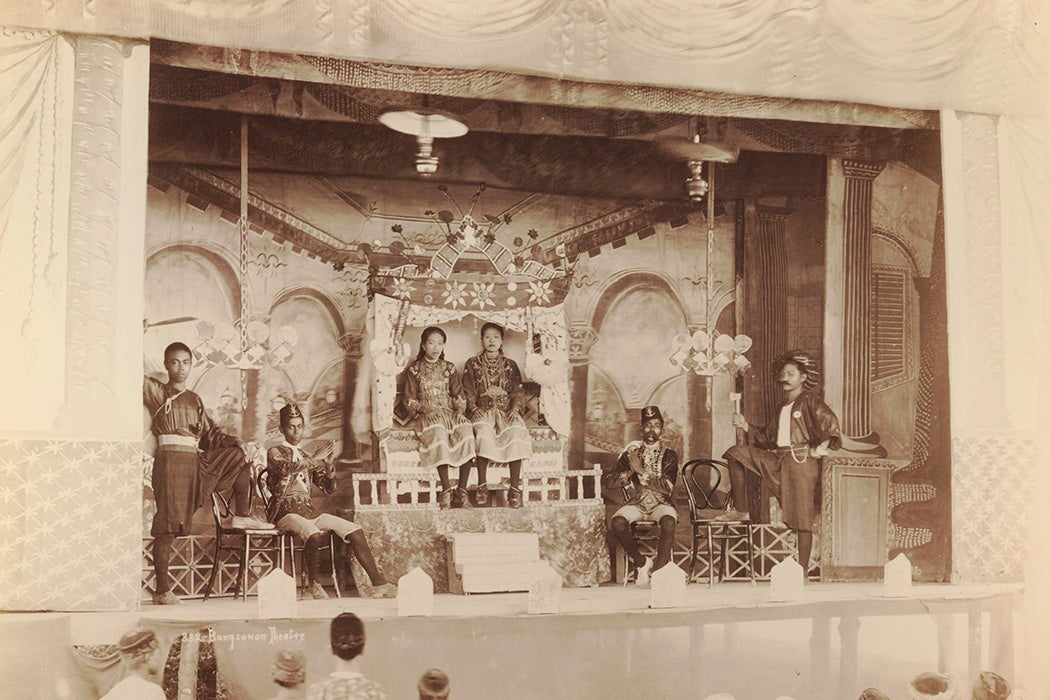Growing up in Malaya before World War II, most village girls could look forward to a typical life of housework and farm work. But for some, another pathway lay in the glamorous world of the bangsawan stage.
“Through bangsawan, women were afforded the unprecedented opportunity for self-expression in public,” writes ethnomusicologist Tan Sooi Beng.
Before bangsawan, traditional theater was often meant to serve a spiritual purpose, rather than entertainment, and was performed by part-time actors who relied on other work like agriculture. On the other hand, bangsawan’s women stars, or bintang, won recording contracts, “became household names,” and—unlike many of their peers—“were not simply wives or mothers of someone but were seen as having individual personalities of their own.”
Still, the road to stardom was a tough one.
Would-be stars were apprenticed to bangsawan troupes at a young age—even before their teens. Their daily routines could be arduous, with young apprentices spending afternoons in rehearsals. They had a short break to rest, bathe, and eat, but all too soon, it would be time for evening shows.
“Female apprentices were indeed different from ordinary village girls who helped in the house and sometimes went to school. Instead, bangsawan apprentices spent their days practising singing and dancing and learnt how to act different women’s roles,” Tan reports.
Young apprentices also had to learn by observation, especially as plays were staged without formal scripts. Directors would simply cast the troupe members in roles and describe the story to them. Indeed, the world of bangsawan required creativity from performers, who were asked “to improvise the dialogue and the accompanying actions, relying only on their ingenuity.”
It also offered apprentices the chance to travel and learn in a cosmopolitan milieu. Minah Alias, who had been performing since she was just four, was the granddaughter of a shadow puppeteer originally from Indonesia. She spent a decade studying dance, music, and acting in Java.
As Tan writes, after “waking up at five in the morning to jog, [Minah Alias] also was required to attend to some household chores.” And then the real work began. “At 1 o’clock, the practice sessions began at which Minah Alias learnt Balinese dances, folk dances, and dances of the kraton (palace). At night, she performed with the Miss Riboet Orient Opera.”
Work to improve skills continued throughout a performing career. Minah Alias “recalled studying kuntau from a Chinese opera actress even after becoming a star, and, in return, she taught silat to the opera actress,” writes Tan.
Yet, despite the unusual freedom, life for bangsawan women was not a story of complete equality. Whether or not they had been born into the trade, performers saw their troupes as a family. They referred to fellow performers as father, mother, brother, or sister, “as they would in their village,” while “[n]ew recruits were adopted as anak angkat (adopted children),” according to Tan.
“Although camaraderie existed, male-female relationships among the members of the troupe were not necessarily equal,” and aspects of the women’s lives remained under the control of men. Though they might be stars on stage, women still bore responsibility for childcare and household tasks in the troupe’s rumah kongsi, or shared lodgings. Tan adds that the women “were not free to go in and out of the rumah kongsi without the permission of the director/manager.” Director/managers, who chose what plays to produce, were also mostly men.
Weekly Newsletter
In or out of the rumah kongsi, women performers were prohibited from drinking, gambling, and meeting men backstage. Yet, because of their profession in a conservative society, “[m]any village elders accused bangsawan women of impiety, of not praying, and of not reading the Koran.”
All the same, the women of the bangsawan stage both “enjoyed a degree of autonomy within the bangsawan community” and “had a greater measure of choice and control over their own lives compared to other village women” in early twentieth-century Malaya.
“Unlike village women,” Tan writes,
bangsawan actresses acquired knowledge of a wider world as they constantly interacted with performers of different nationalities such as Filipinos, Indonesians, Eurasians, Chinese, Indians, and Arabs who were also employed in bangsawan troupes. Malay women also watched foreign films and theatrical performances constantly, so that they could learn and adapt their dances, songs, novelty acts, and tricks.
The art of bangsawan fell into decline in the decade after World War II. Ever versatile, however, the women found new roles for themselves: as actresses or choreographers in the nascent film industry or as dancers and singers in more modern dance troupes.







